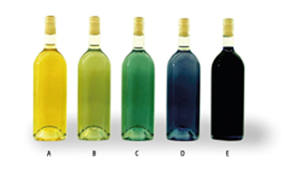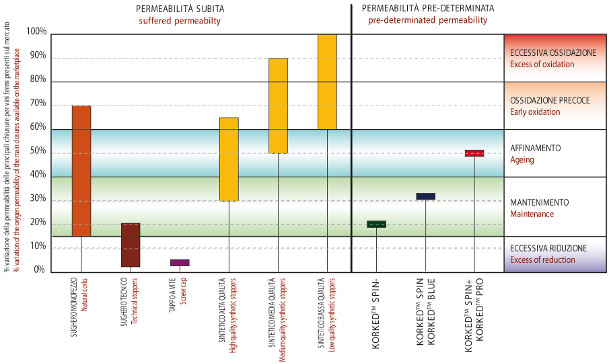Research
Colorimetric Method
In 2001 the University of Udine used, for the first time in Italy, the colorimetric method to measure the permeability to oxygen of different wine closures. The same method had already been used by the Oenology Faculty of the University of Bordeaux, in France.
The bottles are filled up with an indigo-carmine solution, extremely sensible to oxygen. At the beginning the solution is yellow but, on adding some chemical reagents properly calibrated, it turns to green and afterwards to dark blue. The quantity of oxygen that permeates the closure in each unite of time is measured by means of a spectrophotometer of precision.
The picture shows how more is the concentration of oxygen present, more the solution turns to blue:
- Colour a: absence of oxygen
- Colour from b to d: progressive oxidation
- Colour e: 100% oxidation of the liquid

This method has already been used to test and to measure the permeability with more than 40.000 bottles stoppered with all different closures actually available on the market and using plenty different membrane produced by KORKED™ and subjected to various storage conditions.
Ruthenium fluorescence method
Since 2006 Korked and the University of Udine have decided to support the method of fluorescence of the ruthenium to the colorimetric method.
In various bottlings have been stoppered bottles, filled with demineralized water with nitrogen, with statistically representative quantities of different types of closures (natural cork, micro-agglomerated, synthetic stoppers, screw caps).
The method is based on the excitation, through a specific impulse of the blue range, of the sensor containing ruthenium previously inserted inside the bottles. The ruthenium content in the sensor emits in reaction a fluorescent signal in the range of red with a delay, than at the time of excitation, which varies from 1 to 5 milli-seconds. The delay measurement signal, which is a direct function of the amount of oxygen contained in the bottle, determines in scientific way the permeability of the closure with which the bottle was corked.
Results
The values measured with the colorimetric method and with the method of fluorescence of the ruthenium at monthly / quarterly periods till 36 months, processed and converted into data by the University of measurement of permeability of the closure, have allowed Korked after years of study to determine the permeability of the several closures existing in the wine market. A particular study has been dedicated to natural cork monopiece and how vary their permeability as a function of the density of cork that composes them.

These studies have allowed Korked to identify the minimum, medium and maximum permeability of natural cork and to implemented in collaboration with the Politecnico di Milano membranes that replicate scientifically without any defects what nature has created.
At the same time were conducted chemical and sensory analysis of wines bottled with different closures to verify their evolutionary status and to determine for each type of wine the membrane that determines the best aging in bottle from the organoleptic point of view.
Studies managed have allowed to realize the synthetic stopper KORKED™ PRO (medium permeability) and KORKED™ BLUE (low permeability) and screw caps KORKED™ SPIN- (minus) (low permeability), KORKED™ SPIN (medium permeability) and KORKED™ SPIN+ (plus) (high permeability).
The KORKED closures are patented in all most important states in the world from the oenological point of view.


